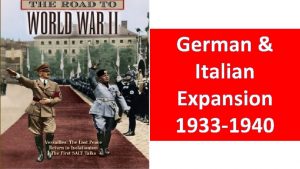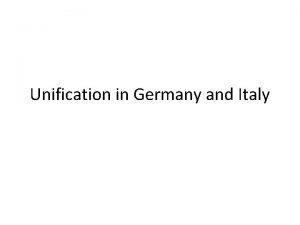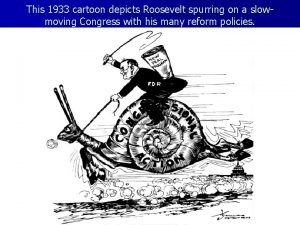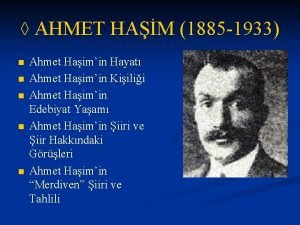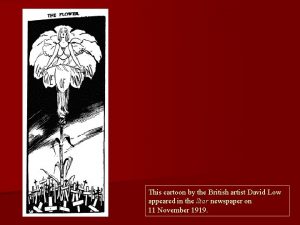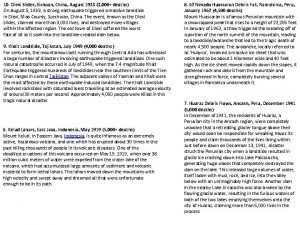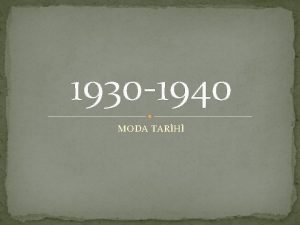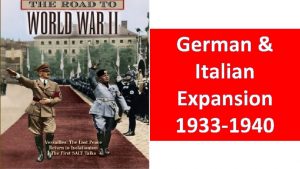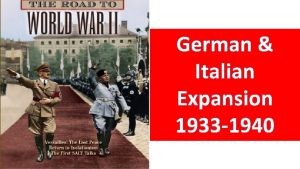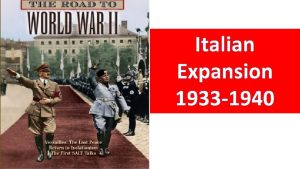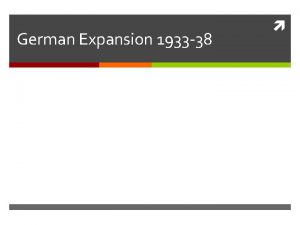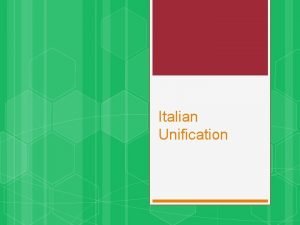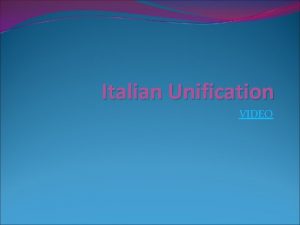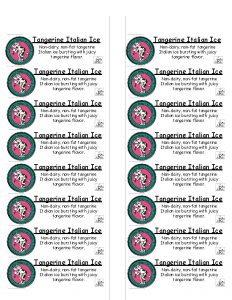German Italian Expansion 1933 1940 From the initial



















- Slides: 19

German & Italian Expansion 1933 -1940

From the initial goal of revising the post-1918 territorial settlement to its culmination in the Second World War, territorial expansion became a defining characteristic of the ideologies and policies in both Italy and Germany, and played a crucial role in their eventual collapse in 1943 -45. Both countries were highly nationalist, and sought to incorporate territory based on ethnic identification. An additional feature of the foreign policies of Italy and Germany, related to their ideologies, was anti-communism.

Italian foreign policy objectives could be said to be based upon expansionary ultra-nationalism but were limited to desires to gain additional territories in the Balkans and in Northern Africa. German foreign policy objectives were huge in scope and related to their racially prejudiced attitudes especially toward Jews and Eastern European Slavs. Foreign policy aims in both Fascist Italy and Nazi Germany were heavily concerned with revising or rolling back many of the provisions of the Treaty of Versailles and other major agreements signed in the years following World War I.

ITALY The rise of fascism in Italy, and the subsequent move towards an imperialistic and expansionary foreign policy, has roots in the Treaty of Versailles.

This image shows the territory that was promised to Italy under the Treaty of London, an agreement signed in 1915 in which Italy aligned itself with the Triple Entente (Britain, France, and Russia). According to the terms of this treaty, Italy would be granted large pieces of territory along the eastern Adriatic and the Dalmatian Coast.

By the end of World War I Italy had mobilized nearly 5 million troops and had suffered over 600, 000 dead. However, despite Italy’s military contributions and the heavy losses that it experienced, the territory that it was ultimately granted under the Treaty of Versailles, which nullified the Treaty of London, was far less than originally promised. The map below describes the lands that Italy was actually granted:

The Wilson line, seen above, drastically reduced what was given to Italy. Dalmatia was excluded, as was Fiume; so, too, were any colonial territories in Africa or Asia and any claim on Albania. Nationalists consequently argued that Italy had been robbed of its rightful gains. This unhappiness with the results of the Treaty of Versailles helped set the stage for the fascist rise to power in Italy and in turn helped shape Italian foreign policy under Benito Mussolini.

Italy's foreign policy under Benito Mussolini had to be strong to show the world how powerful Italy was under his leadership. As leader of Italy, Mussolini wanted to re-establish the greatness of the Roman Empire. Mussolini believed that conquered foreign territory was the sign of a great nation and a great power.

He believed that Italy should be allowed a sphere of influence in the Mediterranean Sea as he believed that Italy was the most powerful Mediterranean country. Mussolini referred to the Mediterranean Sea as Mare Nostrum – the same as the Romans had done when they dominated Europe. Mare Nostrum translates as "Our Sea".

However, the nation that effectively dominated the Mediterranean was Great Britain as Britain had strong naval bases in Malta, Gibraltar and Cyprus. Britain also controlled the Suez Canal, along with the French. Therefore, there was a non. Italian presence that undermined Italy’s standing in the Mediterranean. Britain could control the Mediterranean Sea – something Mussolini wished to do.

With Italian claims to Albania and Abyssinia nullified, Mussolini felt trapped because Britain and France controlled the two major entrances to the Mediterranean – the Straits of Gibraltar and the Suez Canal. Driven by a fascist desire for expansion and strategic concerns that Britain and France could cut off Italy from trade and essential materials, Mussolini adopted a much more aggressive foreign policy.

While Imperialism was always a facet of fascism it was not explicit until 1935. The need to provide space for Italian emigration was emphasized by the occupation of Abyssinia (present day Ethiopia) from 1935 -36. The excuse for the attack came in an incident during December 1934 between Italian and Abyssinian troops at the Wal oasis on the border between Abyssinia and Italian Somaliland.

Mussolini demanded an apology while also preparing the Italian army to invade. Italy quickly conquered the underprepared Abyssinians who were vastly outgunned by the Italian military forces. This push towards more overt imperialism highlights another way that fascism shaped Italian foreign policy: through strategic alliances, the most important of which was with Germany.

Mussolini was frankly impressed by German efficiency, and was willing to overlook competing interests in Austria and the Balkans that might have negatively affected the relationship between the two countries. In 1936 Mussolini agreed to the Rome-Berlin Axis, pledging cooperation in central Europe.

This marked a distinct shift in Italian foreign policy as it completely realigned the country away from Britain and France. Mussolini believed that aligning with Germany was the best way to revise or nullify the provisions of the Treaty of Versailles. The next year, on November 6, 1937, Italy joined with Germany and Japan in the Anti-Comintern Pact, an alliance designed to offset the growing influence of the Soviet Union.

The beginnings of the pact go back to 1935 when Germany was trying to balance its foreign policy with the country’s historical alliance with Japan. Lack of interest in China however, ultimately doomed it initially. A year later, in 1936, with the rise of Japanese military power and the influence of military officials in Japan’s government, convinced Hitler to revive aspirations of the pact, this time focusing on Japan. Italy’s decision to join the pact with Germany and Japan is widely regarded as a response to collapse of the Stresa Front, a Franco-British initiative that included Italian participation and was designed to prevent German expansion.

By the time that Italy had formalized its military ties with Germany in the so-called Pact of Steel in 1939, Mussolini had identified his country's interests with those of Hitler to the point that Italy had almost become a German satellite.

Also known as The Pact of Friendship and Alliance between Germany and Italy, The Pact of Steel was the agreement with which Germany and Italy publicly entered into an alliance, pledging mutual support in war and war production, while requiring that, in the case of war, one nation could not negotiate for peace without agreement of the other. Secret clauses in the pact urged both nations to increase the level of cooperation in war planning and war production and to coordinate propaganda efforts.

The agreement was signed by Count Galeazzo Ciano for Italy and Joachim von Ribbentrop for Germany, and the signing took place in Berlin, Germany. The nickname "The Pact of Steel" was coined by Italian leader Benito Mussolini, who thought the originally proposed nickname of "Pact of Blood" would be poorly received in Italy. It was this agreement that formally created the Axis Powers, which would later include Japan.
 German and italian expansion
German and italian expansion Low german vs high german
Low german vs high german German and italian unification compare and contrast
German and italian unification compare and contrast Pangalawang bansang kolonyal sa asya
Pangalawang bansang kolonyal sa asya National industrial recovery act of 1933
National industrial recovery act of 1933 Night of the long knives cartoon
Night of the long knives cartoon 1933 cartoons
1933 cartoons Csci 1933 umn
Csci 1933 umn Congresso ciam
Congresso ciam La buena fama durmiendo
La buena fama durmiendo Bodas de sangre 1933
Bodas de sangre 1933 Cartoon 1933
Cartoon 1933 Someone is taking someone for a walk cartoon meaning
Someone is taking someone for a walk cartoon meaning Kolmogorov 1933
Kolmogorov 1933 Seyreyledim eşkal-i hayatı ben havz-ı hayalin sularında
Seyreyledim eşkal-i hayatı ben havz-ı hayalin sularında Carta de atenas
Carta de atenas Cartoon by david low 1933
Cartoon by david low 1933 Larsonneur 1933
Larsonneur 1933 Diexi slides
Diexi slides 1940 moda
1940 moda
